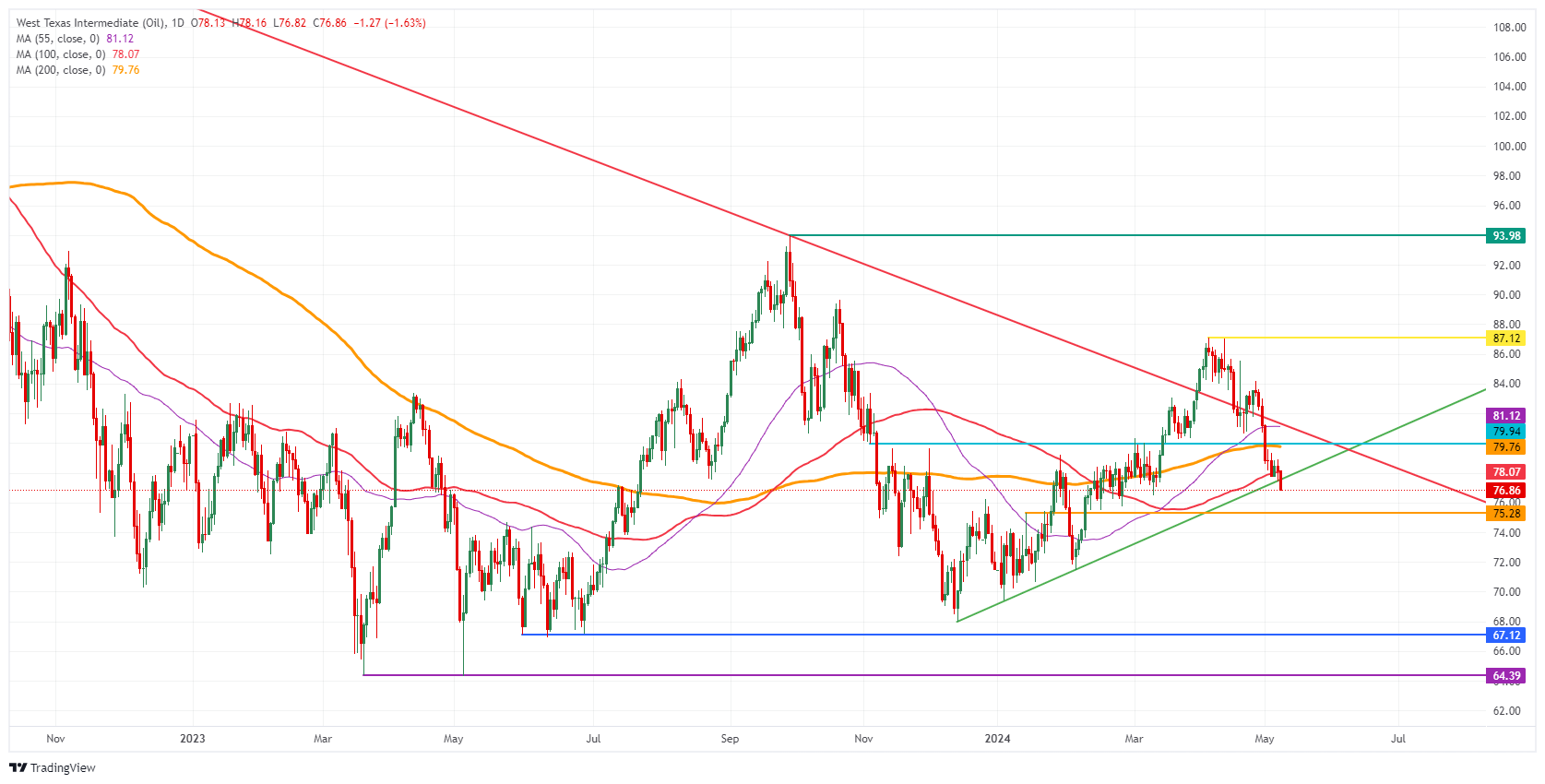- Oil nearly erases all intraday losses after EIA release.
- WTI Oil hangs around $78 after a dive to $76.76 earlier.
- The US Dollar Index ticks up with help from the Japanese Yen and market uncertainty.
Oil prices are heading back to $78 after a steep decline earlier with West Texas Intermediate (WTI) US crude prices nearly reaching their lowest levels in almost two months. Markets did not respond well to the headline that Iran plans to add between 300,000 and 400,000 barrels per day in its production for this year, reported by Bloomberg on Wednesday. The confirmation came from Iranian Oil Minister Javad Owji on state TV, and means mayhem for the next OPEC meeting, where prolonging production cuts is the topic of discussion.
Meanwhile, the US Dollar Index (DXY) is grinding higher this week, posting gains for a third consecutive day, in joint cooperation with the USD/JPY pair, where the Japanese Yen (JPY) has already devalued half the move it gained on the Japanese interventions over the past two weeks. The underlying bullish tone around the US Dollar (USD) might continue to weigh on Crude Oil prices
Crude Oil (WTI) trades at $77.83 and Brent Crude at $82.09 at the time of writing.
Oil news and market movers: EIA numbers faec retreat
- At 14:30 GMT, the Energy Information Administration (EIA) has released this week's Crude Stockpile numbers. Previous was a build of 7.265 million barrels and revealed a draw down by 1.326 million barrels.
- The American Petroleum Institute (API) reported on Tuesday that US Crude Inventories built by 509,000 barrels the week ending on May 3. The derivatives such as Cushing, Gasoline, and Distillates all saw buildings in their segments as well, Bloomberg reports.
- The Energy Information Administration (EIA) issued a note on Wednesday saying that it sees the Oil market remaining balanced for 2024, pointing to non-OPEC countries filling in the gap of OPEC’s production cuts, Reuters reports.
- Bloomberg Intelligence reporters Will Hares and Salih Yilmaz said in a note on Wednesday that OPEC+ (Organization of the Petroleum Exporting Countries and allies) has reason enough to prolong its production cuts, seeing the recent decline in Oil prices from $87.12 on April 5 to $77.01 on Wednesday.
Oil Technical Analysis: Small draw down does not mean substantial turnaround
Oil prices are cooling down further as the risk of interruptions in Oil production from the Middle East isn’t taking place. As traders look to be fed up with pricing in a risk premium for something that is still not happening, this sees some capitulation in the Oil price where only $75.28 looks to be only solid support level left refraining from Oil to dip to $70.00.
Still, a turnaround could occur once Oil prices recover back above $78.07, with the 100-day Simple Moving Average (SMA) and the green ascending trend line from December acting as support. Next on the upside, the 200-day SMA at $79.76 and the 55-day SMA at $81.12 are the levels to watch for some profit-taking. In the longer term, $87.12 remains the big level on the upside.
On the downside, the pivotal level at $75.28 is the last solid line in the sand that could end this decline. If this level is unable to hold, expect to see an accelerated selloff towards $72.00 and $70.00. That would mean that all gains for 2024 are given up and Oil could test $68, the December 13 low.
US WTI Crude Oil: Daily Chart
WTI Oil FAQs
WTI Oil is a type of Crude Oil sold on international markets. The WTI stands for West Texas Intermediate, one of three major types including Brent and Dubai Crude. WTI is also referred to as “light” and “sweet” because of its relatively low gravity and sulfur content respectively. It is considered a high quality Oil that is easily refined. It is sourced in the United States and distributed via the Cushing hub, which is considered “The Pipeline Crossroads of the World”. It is a benchmark for the Oil market and WTI price is frequently quoted in the media.
Like all assets, supply and demand are the key drivers of WTI Oil price. As such, global growth can be a driver of increased demand and vice versa for weak global growth. Political instability, wars, and sanctions can disrupt supply and impact prices. The decisions of OPEC, a group of major Oil-producing countries, is another key driver of price. The value of the US Dollar influences the price of WTI Crude Oil, since Oil is predominantly traded in US Dollars, thus a weaker US Dollar can make Oil more affordable and vice versa.
The weekly Oil inventory reports published by the American Petroleum Institute (API) and the Energy Information Agency (EIA) impact the price of WTI Oil. Changes in inventories reflect fluctuating supply and demand. If the data shows a drop in inventories it can indicate increased demand, pushing up Oil price. Higher inventories can reflect increased supply, pushing down prices. API’s report is published every Tuesday and EIA’s the day after. Their results are usually similar, falling within 1% of each other 75% of the time. The EIA data is considered more reliable, since it is a government agency.
OPEC (Organization of the Petroleum Exporting Countries) is a group of 13 Oil-producing nations who collectively decide production quotas for member countries at twice-yearly meetings. Their decisions often impact WTI Oil prices. When OPEC decides to lower quotas, it can tighten supply, pushing up Oil prices. When OPEC increases production, it has the opposite effect. OPEC+ refers to an expanded group that includes ten extra non-OPEC members, the most notable of which is Russia.
Information on these pages contains forward-looking statements that involve risks and uncertainties. Markets and instruments profiled on this page are for informational purposes only and should not in any way come across as a recommendation to buy or sell in these assets. You should do your own thorough research before making any investment decisions. FXStreet does not in any way guarantee that this information is free from mistakes, errors, or material misstatements. It also does not guarantee that this information is of a timely nature. Investing in Open Markets involves a great deal of risk, including the loss of all or a portion of your investment, as well as emotional distress. All risks, losses and costs associated with investing, including total loss of principal, are your responsibility. The views and opinions expressed in this article are those of the authors and do not necessarily reflect the official policy or position of FXStreet nor its advertisers. The author will not be held responsible for information that is found at the end of links posted on this page.
If not otherwise explicitly mentioned in the body of the article, at the time of writing, the author has no position in any stock mentioned in this article and no business relationship with any company mentioned. The author has not received compensation for writing this article, other than from FXStreet.
FXStreet and the author do not provide personalized recommendations. The author makes no representations as to the accuracy, completeness, or suitability of this information. FXStreet and the author will not be liable for any errors, omissions or any losses, injuries or damages arising from this information and its display or use. Errors and omissions excepted.
The author and FXStreet are not registered investment advisors and nothing in this article is intended to be investment advice.
Recommended content
Editors’ Picks

Gold price taps $3,300; fresh record high amid trade war concerns and weaker USD
Gold price continues scaling new record highs through the Asian session on Wednesday and has now moved well within striking distance of the $3,300 round-figure mark. Persistent worries about the escalating US-China trade war and US recession fears amid the ongoing US tariff chaos continue to boost demand for gold.

EUR/USD holds firm above 1.1350 amid renewed US Dollar weakness
EUR/USD is storngly bid above 1.1350 in European trading on Wednesday. The pair draws support from a fresh round of selling in the US Dollar amid persistent fears over US-China trade war and a lack of progress on EU-US trade talks. US consumer data and Powell speech are in focus.

GBP/USD trades at fresh 2025-high above 1.3250 after UK CPI data
GBP/USD builds on its six-day winning streak and trades at its highest level since October above 1.3250 in the European session on Wednesday. The data from the UK showed that the annual CPI inflation softened to 2.6% in March from 2.8% in February but had little impact on Pound Sterling.

Exchange inflows surge as XRP slides, what comes next?
Ripple corrected along with other major digital assets, including Bitcoin and Ethereum, and traded at $2.08 at the time of writing on Wednesday. The drawdown cut across the crypto market, causing the total capitalization to drop 3.2% to $2.736 trillion.

Is a recession looming?
Wall Street skyrockets after Trump announces tariff delay. But gains remain limited as Trade War with China continues. Recession odds have eased, but investors remain fearful. The worst may not be over, deeper market wounds still possible.

The Best brokers to trade EUR/USD
SPONSORED Discover the top brokers for trading EUR/USD in 2025. Our list features brokers with competitive spreads, fast execution, and powerful platforms. Whether you're a beginner or an expert, find the right partner to navigate the dynamic Forex market.




